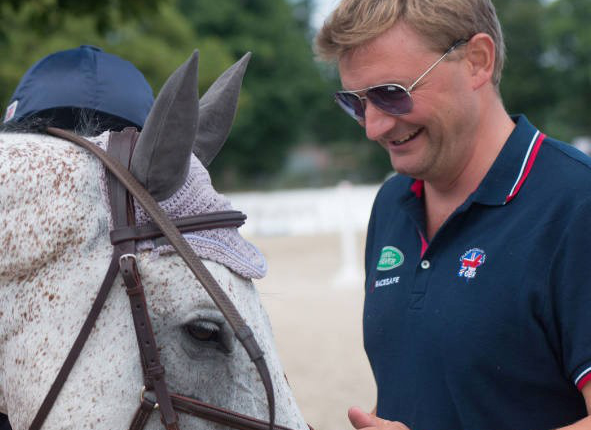Peter ‘Spike’ Milligan is a highly experienced equine vet who specialises in the management of performance horses.
In 2020 Spike set up his own operation, Spike Milligan Performance Horse Consultant, delivering a holistic approach to managing the performance horse to ensure that they are able to compete at close to their genetic potential.
Spike specialises in the diagnosis and management of respiratory issues and the other common medical problems which present in performance horses. He is the Youth Performance Vet for Team GB Eventing and loves helping young and developing riders, ensuring both they and their mounts achieve their potential. He is also a big fan of National Hunt racing.
In your experience, how widespread is respiratory disease in horses? What proportion of horses are likely to be affected? How big a problem is this for eventers?
Respiratory disease is commonly found in horses of all types, but the relevance of low-grade disease becomes heightened as horses perform closer to their full athletic potential. For example, a grassroots eventer could still find their performance limited by their horse’s respiratory tract if the horse either has more severe disease or if its own engrained fitness is lower.
As horses go up the levels they will get closer to their own athletic limit and then low-grade disease becomes more relevant. If you compare this to human athletes – elite level cyclists are often treated with ‘asthma’ medication but that isn’t because they have asthma like us mere mortals. They are being treated for low level disease and inflammation that would be limiting to them at their extreme level of exercise.
How fundamental is respiratory health to a horse’s wellbeing and performance?
Ensuring respiratory health is a key contributor to ensuring good horse welfare. For competition horses we are usually looking at managing relatively low levels of disease, but all diseases are progressive if not appropriately treated and managed, and there can be long term effects on the lungs that can reduce life expectancy in some horses. The emphasis should be on managing most conditions rather than ‘curing’ per se.
What are the main causes of respiratory problems and disease for horses in the UK?
Leaving aside respiratory pathogens such as equine flu and equine herpes virus, the most common respiratory problems are multifactorial and a combination of factors can lead to clinical disease. The inhalation of airborne particles and the simple irritation to the mucosal lining of the respiratory tract is one very common factor.
These particles can take the form of outside environmental allergens such as pollens, grasses and dust as well as indoor allergens such as spores (from bedding or forage), or dust and vapours from dirty bedding. Horses don’t need to have true allergy to these things for the horse to develop disease as the presence of these particles will irritate the mucosa and lead to inflammation, which in turn leads to presenting clinical signs.
What are the effects of respiratory problems/ disease on a horse’s health, wellbeing and performance?
Respiratory disease can present in obvious ways, such as a cough and/or nasal discharge. In subtler ways it will lead to poor performance and reduced stamina as horses will tire early due to a reduced amount of oxygen being taken up by the blood from the lungs.
When horses are tired, they can be more susceptible to orthopaedic injuries due to muscle fatigue, and also to exertional rhabdomyolysis (tying-up) due to increased lactic acid build up as the muscle cells need to source their energy from anaerobic respiration and not aerobic respiration. (The difference is complicated but well worth looking up.) This will also lead to extended recovery times after exercise and poor performance the next day which is key for horses competing at three-day events when required to show jump on the last day.
Does respiratory disease become more common in older horses? In other words, can it be an accumulative condition that may not show symptoms for years?
Undiagnosed and therefore poorly managed respiratory disease can lead to chronic changes and scarring within the lungs over a protracted period of time. Older horses are potentially more susceptible to viral diseases and this could trigger more acute respiratory disease.
Are there any parallels between human and equine respiratory disease that would help owners understand how serious/widespread this is, and what their horses are experiencing?
I’ve mentioned before the comparison between human athletes and our equine athletes in understanding how even mild disease can be a limiting factor for high level competition. Beyond this, everyone is acutely more aware of respiratory viruses with the huge impact of COVID-19.
Even an awareness of human asthma and how common that is even for people that may just get a tickle in their throat when the pollen count is high rather than full blow allergy. Horses are just as susceptible and it can be a challenge to identify low grade and subclinical disease, so preventative strategies are essential in controlling the disease.
We’ve been promoting the message that dust in the stable is the biggest cause of respiratory disease – so how important is it to use the cleanest possible bedding?
Your horse’s immediate environment is the most important factor. We can’t control the external environment, but you can manage your horse’s stable environment and that can have a huge influence on ensuring a healthy respiratory tract. Clean bedding is the absolute cornerstone for this and therefore a fundamental part of preventative healthcare.
I am amazed at how many stables have cobwebs all over the ceiling, beams and in the corners. Not only is this poor stable hygiene but also indicates poor airflow through the stable. Being fastidious about your horse’s stable environment will definitely reduce the risk of respiratory disease – and therefore reduce your vet bills as treatments can be expensive and lengthy.




